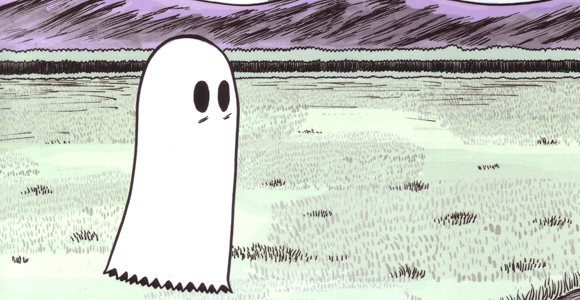Sacrifice – Sam Humphries (w) Dalton
Rose (a)
Self-published,
$3.99, six-issue miniseries
While self-publishing comics is nothing new, self-distributing is an altogether ballsier move. Sam Humphries showed that he knew how to work
the system, though, with last year’s one-shot Our Love is Real — a story about people having sex with dogs and
vegetables. Puerile subject-matter
aside, what was shocking about that comic was how successful it became without
any reliance on Diamond Comic Distribution. Instead, the creators sold direct to comic
shops, and with some viral marketing and a little help from hyperbole-addict
Rich Johnson’s Bleeding Cool website,
it sold out of its first printing…and its four other subsequent printings. While that put it at a little over 1,000
copies sold, for a book about zoophilia, that’s not bad.
Humphries has returned with a longer series, Sacrifice, which carries a more serious tone, but retains the same
business model. It seems to be working
and the first two issues have sold out of their first printings, with the book
keeping momentum with a regular bi-monthly schedule. But the main question is, beneath all the
hype, is it any good?
From the first three issues, signs would point to yes. Humphries is certainly a writer of
imagination and the set-up for the series is elegant, yet intriguing. Hector is a young Joy Division fan (he wears
an Unknown Pleasures t-shirt
throughout the series) who is suffering from epilepsy, and as a possible result
of a tattoo he has, he finds himself travelling in time to an ancient Aztec
civilization. Whether this is real, or
is simply a by-product of his condition, is one of the series’ central enigmas. But surrounding Hector’s time-travelling
antics are his domestic issues with his family who are struggling to cope with
his illness, and his own teenage existential dilemmas.
In Dalton Rose, Humphries has discovered a raw new talent and a worthy
collaborator. His angular, clear lines are
slick enough to suggest the contemporary sheen of now, but he’s also not afraid
to steep his pages in pools of black to really bring out the mystery and
malevolence of the Aztec scenes. There’s
clear influence from Paul Pope and Mike Allred in his work, yet he has a strong
grasp of body language and action that it never feels swiped or too
derivative. In fact, in some of the book’s
trippier sequences, we begin to see a real distinct voice emerging, and it’s a
real joy to see a young artist cut their teeth on something so unique, rather
than rehashing genre tics that have been played-out countless times before.
Selling a book based on the Aztecs and Joy Division was probably not
the safest move in comics, especially with such a risky distribution
method. However, that shows the
conviction that Humphries and Rose have in their work — this isn’t a
shock-tactic gimmick that might get some curiosity purchases, nor is it a model
than can ride the speculator train indefinitely. So, it’s just as well that the content
justifies their reputation.
-- Gavin Lees






























